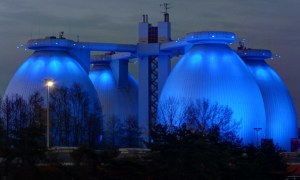🕑 Reading time: 1 minute
Living in a densely populated city is no longer a dream and has become quite a nightmare. The rampant environmental degradation, traffic congestion, and inadequate urban infrastructure in big cities has become an everyday sight.
To add to it, over two-thirds of the global population is predicted to reside in an urban setting by 2050. It can lead to serious ramifications when faced with extreme weather conditions like unexpected storms, flooding, etc.
This calls for thoughtful measures for creating sustainable cities, which can adapt to mitigate and promote economic, social, and environmental change. It has also featured as one of the missions for achieving sustainable cities and communities in the United Nations’ 17 Sustainable Development Goals.
The targets for achieving this goal include reducing the adverse effects of natural disasters, creating green spaces for everyone, and addressing the environmental impact of cities. Based on this, we have enlisted six innovative ways adopted by cities to tackle this imminent threat.
Contents:
1. Smart Commuting
Transportation has become a chaotic experience for many of us because of the multiplying population and expanding cities due to the skyrocketing prices of land. A sustainable city needs to incorporate smart commuting options to facilitate ease of traveling and to keep a check on pollution levels. The establishment of a smart transportation system requires coordination between the public transport companies, city authorities, and other stakeholders.
One of the emerging choices for green modes of transit is the self-driving electric vehicle, which is reinventing the way we commute. These autonomous vehicles offer intelligent and clean mobility solutions. Not only do they reduce traffic congestion, but also eliminate the need for parking spaces as they are continuously on the run.

Image Courtesy: Navya
One such example is the Autonom Shuttle Evo, which won two awards at the Dubai World Challenge for Self-Driving Transport. The automated guideway transit (AGT) is another developing technology suitable for sustainable cities. AGT vehicles are fully automated and driverless transit system that runs on a light guideway.
2. Sponge Cities
Sponge cities are designed based on the concept of absorbing rainwater and dispersing it back slowly. These are named so as the cities comprise of porous surfaces and spaces capable of retaining water. Sponge cities are already prevalent in countries like China and Singapore.
The concept includes permeable roads, green roofs, wetlands, and natural vegetation, which absorb, infiltrate, store, purify, drain, and manage the rainwater. The harvested rainwater can be repurposed for irrigation and domestic use.

Image Courtesy: Obermeyer
Sponge cities also provide a sustainable drainage solution while mitigating the crisis of water shortage. The technique would also protect the cities from natural calamities like floods and droughts.
3. Vertical Gardens
As metropolitan cities are running short on land, architects envisaged gardens on vertical spaces. The prototype, known as Vertical Forest, was built in Italy and features two towers housing 800 trees, 15,000 perennials, and 5,000 shrubs.

Image Courtesy: Stefano Boeri Architetti
Vertical gardens develop an urban ecosystem by creating a vertical environment also suitable for birds and insects. It shows architectural biodiversity focusing on the relationship between humans and other living species.
4. Miniature Urban Forests
Miniature forests can be conceived on patches of land in the middle of an urban landscape. The forests are planted using the Miyawaki method inspired by Japanese temples.

Image Courtesy: APUR/Céline Orsingher
In essence, the idea is to choose brownfield sites and plant several types of native seedlings. The seeds are then allowed to grow with minimal intervention, resulting in small ecosystems perfectly suited to local conditions. Though small in size, miniature forests are capable of improving the biodiversity and also absorb more carbon dioxide, with the potential to help combat climate change.
5. Linear Parks
Several elevated historic rail lines or highways in the US are being transformed into lush recreational spaces known as linear parks. Linear parks are long parks extending horizontally which are an excellent way to add greenery to urban areas as they don't require any extra land.

Image Courtesy: Colin Hinkle
These parks can be created from old rail lines, capped highways, boulevards, or bridges to serve as playgrounds, picnic places, etc. Their long and winding shape provides greater access to visitors, while also encouraging them to be on the move.
A perfect example is the 606 linear park in Chicago. It is a 2.7-mile multi-use park constructed on the obsolete Bloomingdale elevated rail line. Apart from promoting outdoor activities, the trail has significantly boosted the real estate prices in the region.
6. The 20-minute Neighborhood
The 20-minute neighborhood concept creates small neighborhoods within the city, with most of the essentials accessible within a 20-minute walk from home. The neighborhood also provides options for safe cycling and local transport.

Image Courtesy: State Government
of Victoria
The Australian city of Melbourne is already turning the concept into reality as part of the Victorian Government’s Plan Melbourne strategy.
Conclusion
We must acknowledge the fact that our planet is not prepared to handle such extreme exploitation. Many metropolitan cities worldwide are already struggling to provide essential utilities like water supply, sanitation, and waste management.
These cities have an alarming environmental footprint, which can jeopardize the natural resources required for economic development and poverty alleviation. In today’s unpredictable world of unanticipated circumstances, the most significant urban challenge is maintaining economic growth in a sustainable, liveable city for the masses.
Read More
6 Sustainable Innovations Shaping Construction


